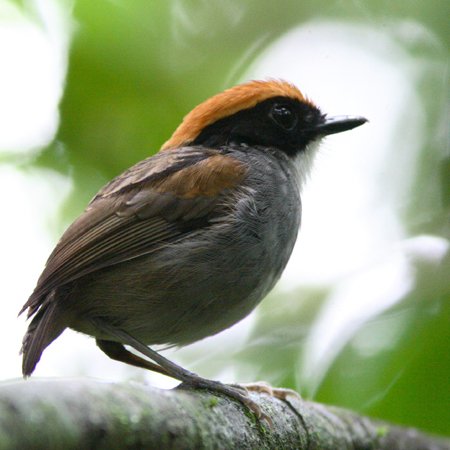Conopophagidae – Gnateaters

The gnateaters are a bird family, Conopophagidae, consisting of eleven small passerine species in two genera, which occur in South and Central America. The family was formerly restricted to the gnateater genus Conopophaga, however, analysis of mtDNA cytochrome b and NADH dehydrogenase subunit 2 sequences (Rice 2005a,b) indicates that the ‘antpittas’ of the genus Pittasoma also belong in this family. The association between this genus and Conopophaga is also supported by traits in their natural history, morphology, and vocalisations. The members of this family are very closely related to the antbirds and less closely to the antpittas and tapaculos. Due to their remote and dim habitat, gnateaters are a little-studied and poorly known family of birds.
They are round, short-tailed, and long-legged birds, about 12–19 cm in length, with Pittasoma being larger than Conopophaga. They are quite upright when standing. All species are sexually dimorphic, although the extent of this varies greatly. Most Conopophaga species have a white tuft behind the eye.
Gnateaters are birds of the forest understory, bamboo stands, and the forest floor. The members of the genus Conopophaga are found in the Amazon and Orinoco basins, east and central Andean slopes, Atlantic Forest, and nearby regions, while the members of the genus Pittasoma are found in the Chocó, and Panama and Costa Rica. Some species live in impenetrable thickets; others live in more open forest. Most are entirely restricted to humid habitats, but several species extend into drier regions in eastern Brazil. While the members of the genus Conopophaga always are found near the forest floor, seldom rising more than 1.5 m above the ground, they also seldom travel or spend much time on the ground (though they do feed there). The members of the genus Pittasoma are more commonly seen hopping around on the ground.
Gnateaters are insectivorous as the group name implies. The members of the genus Conopophaga feed mostly using two methods; one is to perch above the forest floor until prey is spotted, then lunge down to the ground to snatch it; having landed on the ground to snatch a prey item it will not remain on the forest floor for more than a couple of seconds. The second method used is to glean insects directly from the foliage, trunks, and branches of low vegetation. Typical prey items include spiders, caterpillars, insect larvae, grasshoppers and beetles; individuals of some species have also been observed eating fruit and in one case a frog. Very little information is available on the diet of the two Pittasoma, but they are also presumed to be insectivorous, and have been recorded following army ants swarms.
After DNA sequencing showed that the two antpittas form part of this group, most authorities believe that there are 11 species in this family, which are:
Rufous Gnateater Conopophaga lineata
Ceara Gnateater Conopophaga cearae
Chestnut-belted Gnateater Conopophaga aurita
Hooded Gnateater Conopophaga roberti
Ash-throated Gnateater Conopophaga peruviana
Slaty Gnateater Conopophaga ardesiaca
Chestnut-crowned Gnateater Conopophaga castaneiceps
Black-cheeked Gnateater Conopophaga melanops
Black-bellied Gnateater Conopophaga melanogaster
Black-crowned Antpitta Pittasoma michleri
Rufous-crowned Antpitta Pittasoma rufopileatum
-
Black-cheeked Gnateater Conopophaga melanops
Species AccountThe Black-cheeked Gnateater is a Brazilian endemic distributed along the east coast from Paraíba to Santa Catarina. It is found in dense vegetation in the interior of Atlantic Rain Forest. -
Black-cheeked Gnateater Conopophaga melanops
Species AccountSound archive and distribution map -
Black-cheeked Gnateater Conopophaga melanops
Cornell Species AccountEndemic to the Atlantic Forest of eastern Brazil, between Paraíba in the north and Santa Catarina in the south, this species inhabits wet forest and dense, older second growth in the lowlands and foothills, as well as ranging locally into drier forest. -
Black-cheeked Gnateater Conopophaga melanops
Species AccountThe black-cheeked gnateater (Conopophaga melanops) is a species of bird in the family Conopophagidae endemic to Brazil. -
Rufous Gnateater Conopophaga lineata
BirdLife Species Account -
Rufous Gnateater Conopophaga lineata
Species AccountThe Rufous Gnateater is distributed in eastern Brazil, eastern Paraguay and north-east Argentina. It is found, usually perched close to the ground, in the undergrowth of humid forest and secondary growth… -
Rufous Gnateater Conopophaga lineata
Species AccountSound archive and distribution map -
Rufous Gnateater Conopophaga lineata
Cornell Species AccountThe Rufous Gnateater is a fairly common bird of forest understory. It is best known from the coastal mountains of southern Brazil, where it occurs in montane evergreen forest, especially near thickets of bamboo. -
Rufous Gnateater Conopophaga lineata
Species AccountThe rufous gnateater (Conopophaga lineata) is a passerine bird of the gnateater family, Conopophagidae. It is found in forest understory and bushes in eastern Brazil from Rio Grande do Sul north to central Brazil.
-
Number of bird species: 11
